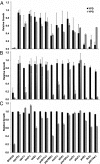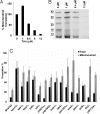A genome-wide screen in Saccharomyces cerevisiae reveals a critical role for the mitochondria in the toxicity of a trichothecene mycotoxin
- PMID: 20007368
- PMCID: PMC2799815
- DOI: 10.1073/pnas.0909777106
A genome-wide screen in Saccharomyces cerevisiae reveals a critical role for the mitochondria in the toxicity of a trichothecene mycotoxin
Abstract
Trichothecene mycotoxins synthesized by Fusarium species are potent inhibitors of eukaryotic translation. They are encountered in both the environment and in food, posing a threat to human and animal health. They have diverse roles in the cell that are not limited to the inhibition of protein synthesis. To understand the trichothecene mechanism of action, we screened the yeast knockout library to identify genes whose deletion confers resistance to trichothecin (Tcin). The largest group of resistant strains affected mitochondrial function, suggesting a role for fully active mitochondria in trichothecene toxicity. Tcin inhibited mitochondrial translation in the wild-type strain to a greater extent than in the most resistant strains, implicating mitochondrial translation as a previously unrecognized site of action. The Tcin-resistant strains were cross-resistant to anisomycin and chloramphenicol, suggesting that Tcin targets the peptidyltransferase center of mitochondrial ribosomes. Tcin-induced cell death was partially rescued by mutants that regulate mitochondrial fusion and maintenance of the tubular morphology of mitochondria. Treatment of yeast cells with Tcin led to the fragmentation of the tubular mitochondrial network, supporting a role for Tcin in disruption of mitochondrial membrane morphology. These results provide genome-wide insight into the mode of action of trichothecene mycotoxins and uncover a critical role for mitochondrial translation and membrane maintenance in their toxicity.
Conflict of interest statement
The authors declare no conflict of interest.
Figures





Similar articles
-
Trichothecene mycotoxins inhibit mitochondrial translation--implication for the mechanism of toxicity.Toxins (Basel). 2011 Dec;3(12):1484-501. doi: 10.3390/toxins3121484. Epub 2011 Dec 2. Toxins (Basel). 2011. PMID: 22295173 Free PMC article.
-
Elimination of damaged mitochondria through mitophagy reduces mitochondrial oxidative stress and increases tolerance to trichothecenes.Proc Natl Acad Sci U S A. 2014 Aug 12;111(32):11798-803. doi: 10.1073/pnas.1403145111. Epub 2014 Jul 28. Proc Natl Acad Sci U S A. 2014. PMID: 25071194 Free PMC article.
-
A Lipid Transfer Protein Increases the Glutathione Content and Enhances Arabidopsis Resistance to a Trichothecene Mycotoxin.PLoS One. 2015 Jun 9;10(6):e0130204. doi: 10.1371/journal.pone.0130204. eCollection 2015. PLoS One. 2015. PMID: 26057253 Free PMC article.
-
Effects of trichothecene mycotoxins on eukaryotic cells: a review.Food Addit Contam. 2005 Apr;22(4):369-78. doi: 10.1080/02652030500058403. Food Addit Contam. 2005. PMID: 16019807 Review.
-
Fusarial toxins: secondary metabolites of Fusarium fungi.Rev Environ Contam Toxicol. 2014;228:101-20. doi: 10.1007/978-3-319-01619-1_5. Rev Environ Contam Toxicol. 2014. PMID: 24162094 Review.
Cited by
-
Bidirectional titration of yeast gene expression using a pooled CRISPR guide RNA approach.Proc Natl Acad Sci U S A. 2020 Aug 4;117(31):18424-18430. doi: 10.1073/pnas.2007413117. Epub 2020 Jul 20. Proc Natl Acad Sci U S A. 2020. PMID: 32690674 Free PMC article.
-
Effects of trichothecene production by Trichoderma arundinaceum isolates from bean-field soils on the defense response, growth and development of bean plants (Phaseolus vulgaris).Front Plant Sci. 2022 Nov 14;13:1005906. doi: 10.3389/fpls.2022.1005906. eCollection 2022. Front Plant Sci. 2022. PMID: 36452093 Free PMC article.
-
Trichothecenes: from simple to complex mycotoxins.Toxins (Basel). 2011 Jul;3(7):802-14. doi: 10.3390/toxins3070802. Epub 2011 Jul 1. Toxins (Basel). 2011. PMID: 22069741 Free PMC article. Review.
-
Trichothecene mycotoxins inhibit mitochondrial translation--implication for the mechanism of toxicity.Toxins (Basel). 2011 Dec;3(12):1484-501. doi: 10.3390/toxins3121484. Epub 2011 Dec 2. Toxins (Basel). 2011. PMID: 22295173 Free PMC article.
-
RNA-Seq Revealed Differences in Transcriptomes between 3ADON and 15ADON Populations of Fusarium graminearum In Vitro and In Planta.PLoS One. 2016 Oct 27;11(10):e0163803. doi: 10.1371/journal.pone.0163803. eCollection 2016. PLoS One. 2016. PMID: 27788144 Free PMC article.
References
Publication types
MeSH terms
Substances
Grants and funding
LinkOut - more resources
Full Text Sources
Other Literature Sources
Molecular Biology Databases

